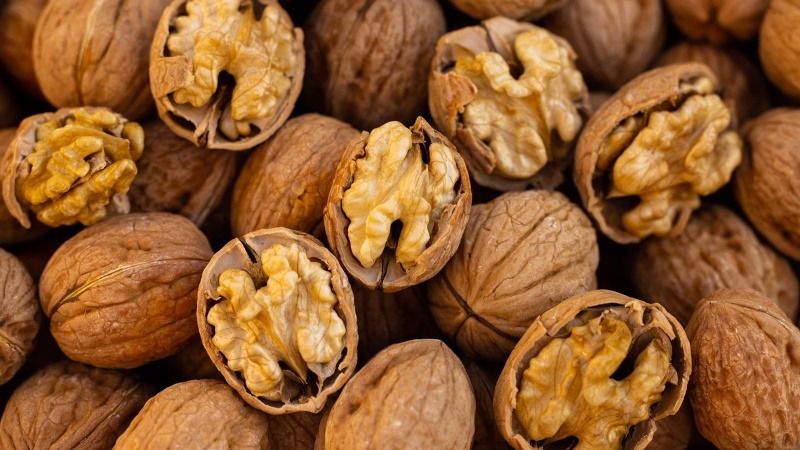
Daily Needs
You might be wondering how much ALA, EPA and DHA you need. Adequate Intake for ALA is 1.1 g/day for women and 1.6 g/day for men (0.5% energy).[10] And while there is no recommended daily intake for EPA & DHA, various health organizations and research recommends 250 mg/day.[11,12]
ALA Food Sources
Per serving (1 oz.):
- Walnuts (2.57g)
- Ground flax seeds (6.55g)
- Chia seeds (5.05g)
- Soybean oil (0.95g)

Health Benefits of Walnuts
Not only are walnuts an excellent source of ALA (2.5g/oz.), but one ounce of walnuts is a powerhouse of other important nutrients including:
- 4g of protein
- 2g of fiber
- A good source of magnesium (45mg)
Walnut Recipes
Walnuts are easily accessible and versatile, a delicious way to meet the recommended daily intake of plant-based omega-3 ALA. Grab a handful of walnuts for a snack or incorporate them into recipes such as: Walnut Chorizo and Goat Cheese Mini Pizza Bites, Strawberry Walnut Date Smoothie, or Spicy Walnut Blue Cheese and Blood Orange Salad. For more recipe inspiration visit walnuts.org/recipes.
The post Can I get omega-3s from plant-based foods? first appeared in The Foundation for Fresh Produce’s Have A Plant® blog.
Written by: California Walnuts
The California Walnut Board was established in 1948 to represent the walnut growers and handlers of California. The Board is funded by mandatory assessments of the handlers. The California Walnut Commission, established in 1987, is funded by mandatory assessments of the growers.
REFERENCES
[1] U.S. Department of Agriculture, Agricultural Research Service. FoodData Central, 2019. fdc.nal.usda.gov.
[2] Sala-Vila A, Fleming J, Kris-Etherton P, Ros E. Impact of alpha-linolenic acid, the vegetable omega-3 fatty acid, on cardiovascular disease and cognition . Adv Nutr 2022;00:1–19; doi: https://doi.org/10.1093/advances/nmac016.
[3] Sala-Vila A, Valls-Pedret C, Rajaram S, et al. Effect of a 2-year diet intervention with walnuts on cognitive decline. The Walnuts And Healthy Aging (WAHA) study: a randomized controlled trial. Am J Clin Nut. 2020;111(3):590–600.
[4] Fleming JA, Kris-Etherton PM. The evidence for α-linolenic acid and cardiovascular disease benefits: comparisons with eicosapentaenoic acid and docosahexaenoic acid. Adv Nutr. 2014;5(6):863S-76S. Doi.org/10.3945/an.114.005850.
[5] Dietary reference intakes for energy, carbohydrate, fiber, fat, fatty acids, cholesterol, protein, and amino acids (Macronutrients) (2005) NAS. IOM. Food and Nutrition Board.
[6] Burdge GC. Metabolism of alpha-linolenic acid in humans. Prostaglandins Leukot Essent Fatty Acids. 2006 Sep;75(3):161-8. doi: 10.1016/j.plefa.2006.05.013. Epub 2006 Jul 7. PMID: 16828546.
[7] Brenna JT. Efficiency of conversion of alpha-linolenic acid to long chain n-3 fatty acids in man. Curr Opin Clin Nutr Metab Care. 2002 Mar;5(2):127-32. doi: 10.1097/00075197-200203000-00002. PMID: 11844977.
[8] Gerster H. Can adults adequately convert alpha-linolenic acid (18:3n-3) to eicosapentaenoic acid (20:5n-3) and docosahexaenoic acid (22:6n-3)? Int J Vitam Nutr Res. 1998;68(3):159-73. PMID: 9637947.
[9] Plourde M, Cunnane SC. Extremely limited synthesis of long chain polyunsaturates in adults: implications for their dietary essentiality and use as supplements. Appl Physiol Nutr Metab. 2007 Aug;32(4):619-34. doi: 10.1139/H07-034. Erratum in: Appl Physiol Nutr Metab. 2008 Feb;33(1):228-9. PMID: 17622276.
[10] Vannice G, Rasmussen H. Position of the academy of nutrition and dietetics: dietary fatty acids for healthy adults. J Acad Nutr Diet. 2014 Jan;114(1):136-53. doi: 10.1016/j.jand.2013.11.001. Erratum in: J Acad Nutr Diet. 2014 Apr;114(4):644. PMID: 24342605.
[11] U.S. Department of Agriculture and U.S. Department of Health and Human Services. Dietary Guidelines for Americans, 2010. 7th Edition, Washington, DC: U.S. Government Printing Office, December 2010.
[12] Institute of Medicine. 2005. Dietary Reference Intakes for Energy, Carbohydrate, Fiber, Fat, Fatty Acids, Cholesterol, Protein, and Amino Acids. Washington, DC: The National Academies Press. https://doi.org/10.17226/10490.
About The Foundation For Fresh Produce And Have A Plant® Movement


The Foundation for Fresh Produce’s vision is to grow a healthier world by changing the trajectory of human health. The produce industry has the potential to provide solutions for many of the world’s greatest health and economic challenges – especially those surrounding nutrition and hunger.
The Foundation focuses on improving the appeal of fruit and vegetables as an integral part of people’s diets, supporting the development of infrastructure and supply chain solutions that provide easier access, and establishing strategic alliances that enable children and families to form healthier eating habits.
The transformative Have A Plant® Movement inspires consumers with compelling reasons to believe in the powerful role fruits and vegetables can play to fuel happy, healthy and active lifestyles.



